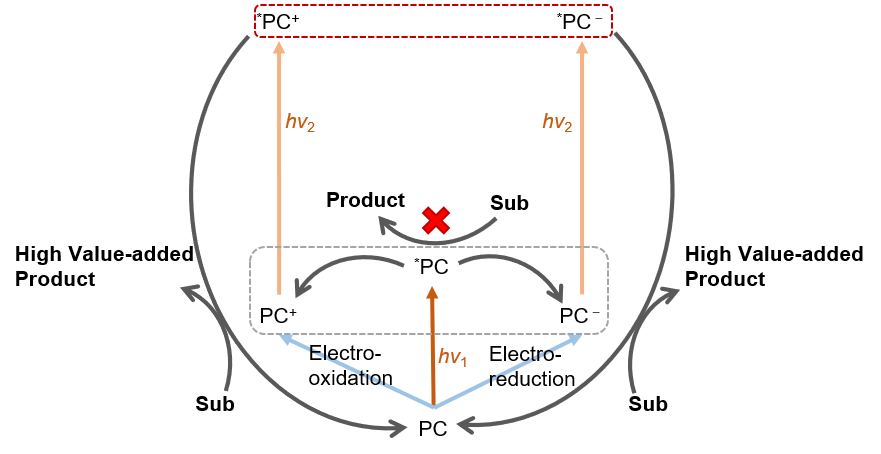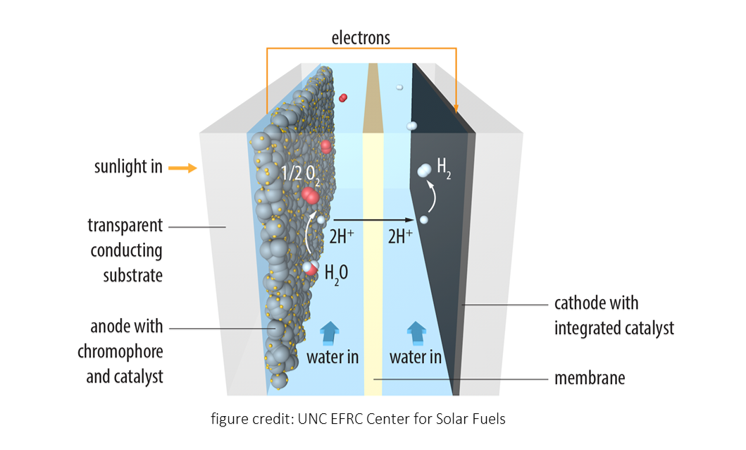物理化学,青年研究员,博士生导师 复旦大学化学系研究员,国家海外青年人才项目入选者。2010年本科毕业于复旦大学化学系,2014年在美国约翰霍普金斯大学获得博士学位,随后赴美国北卡罗莱纳大学教堂山分校化学系、美国能源部能源前沿研究中心:太阳能燃料中心从事博士后研究。长期从事于可见光吸收分子敏化半导体薄膜界面的电子转移动力学研究,并把快反应动力学机理研究成果用于指导分子光伏电池和分子光电催化水分解器件的组装和提高太阳能转化效率。截至2024年共发表论文五十余篇,包括化学或材料类旗舰期刊 Nat. Chem.; J. Am. Chem. Soc .;JACS Au .; ACS Catalysis 等。 学习工作经历:2006.9-2010.6 复旦大学化学系本科,获...
查看更多>
Research Synopsis
The research of our photochemistry group focuses on solar energy as one of the most promising forms of renewable energy and aims to solve the global crisis of climate change concerning our human survival. We aim to transform cheap and ubiquitous substances including H2O, CO2, N2, or lignin into valuable fuels or value-added chemicals such as H2, CO, CH3OH, NH3, etc with sunlight and some “chemical magic”. One of the most important advantages for the students being trained in our research group is getting to learn the “chemical magic”, a.k.a. the understanding of fundamental electron transfer processes through state-of-the-art spectroscopic techniques in our laboratory. Students and Postdocs in our photochemistry group will be immersed in the following research topics:
1. Energy-demanding organic photoredox catalysis and the underlying photochemistry of visible light harvesting molecular photocatalysts
2. Solar fuels production and the underlying photoinduced electron transfer mechanisms
3. Photoelectrochemical devices for artificial photosynthesis
Our independent research is also made possible through very fruitful collaborations:
· Gerald J. Meyer, University of North Carolina at Chapel Hill (UNC), USA
· Renato N. Sampaio, University of North Carolina at Chapel Hill (UNC), USA
· Ludovic Troian-Gautier, UCLouvain, Belgian
· Matthew V. Sheridan, Soochow University, China
· Jianli Hua, East China University of Science and Technology, China
· Baojiang Jiang, Heilongjiang University, China
· Jia Guo, Fudan University, China
· Zhang-Jie Shi, Fudan University, China
Ongoing Research Projects
1. Consecutive Light Excitation Approach to Energy-Demanding Synthesis of Value-Added Chemicals
Inert chemical bonds such as C-H, C-Cl, N≡N, etc. require highly reducing or oxidizing reagents (E < -2 V or > 2 V vs. SCE) to initiate chemical transformations to value-added chemicals. Excited states of typical photocatalysts such as ruthenium or iridium based metal complexes are incapable of achieving such extreme redox potentials. Our research group set out to use small organic photocatalysts that could consecutively absorb multiple photons and reach super-photooxidants or reductants. Our current achievements include using N-phenylphenothiazine (PTH) photocatalyst to do one electron oxidation of chloride and activate C(sp3)-H bonds for the synthesis of functionalized alkanes; using hybrid structure of perylene diimide (PDI) with ZrO2 nanoparticles to activate aryl C-Cl bonds or CO2 reduction catalyst at low catalytic concentrations.

Selected Publications:
2) Zhao, Z.; Niu, F.; Li, P.; Wang, H.; Zhang, Z.; Meyer, G. J.*; Hu, K.*, Visible Light Generation of a Microsecond Long-Lived Potent Reducing Agent. J. Am. Chem. Soc. 2022, 144, 7043-7047.
3) Li, P.; Deetz, A. M.; Hu, J.; Meyer, G. J.*; Hu, K.*, Chloride Oxidation by One- or Two-Photon Excitation of N-Phenylphenothiazine. J. Am. Chem. Soc. 2022, 144, 17604-17610.
2. Photoelectrochemical Cells (PEC) for Artificial Photosynthesis (Liquid Sunlight)
The sun is the most abundant renewable energy upon which a sustainable society can be built. Currently, harvesting 1/7000 of the total solar energy reaching the surface of our earth will suffice the entire energy demand of our human society. Natural photosynthesis in which CO2, water, and sunlight are converted into carbohydrates and dioxygen gives us a perfect example to learn the trick of storing solar energy into high energy chemical bonds. Our research group set out to use visible light absorbing semiconductor based photoelectrodes for the construction of photoelectrochemical cells (PEC) to mimic natural photosynthesis. Our current efforts include using modified bismuth vanadate as the photoanode material for water, glycerol oxidation or organic C-H functionalization; using dye-sensitized photoelectrodes for the construction of tandem cells for total water splitting.

Selected Publications:
Material synthesis and preparation |
||||
|
|
|||
High-speed freezing centrifuge(15,000 rpm) |
Fume hoods &Schlenk Line |
|||
|
|
|||
Tube Furnace(KEJING) |
Freeze drier |
|||
|
||||
Photochemical characterization
|
|
|||
Agilent Cary 60 Ultraviolet-visible Spectrophotometer |
TSP2000 Transient absorption spectrometer |
|||
|
|
|||
Agilent Cary Eclpse Fluorescence Spectrophotometer* (Provided by instrument experimental platform) |
Electrochemical Workstation (CHI760+CHI1232) |
|||
|
|
|||
Xenon Lamp light source (AM 1.5 G) |
GC9790Plus |
|||
|
|
|||
Laser |
Perfect Light Multi-channel Photoreactor |
|||
The large-scale instrument experimental platform of the Department of Chemistry, Fudan University and the State Key Laboratory of Molecular Engineering of Polymers can provide a series of tests such as NMR, XRD, XPS, TEM, SEM, GC-MS, HPLC, etc. for laboratory research. |
||||
Copyright © 2019 复旦大学版权所有
沪ICP备:16018209-1
地址:上海市杨浦区邯郸路220号
邮编:200433